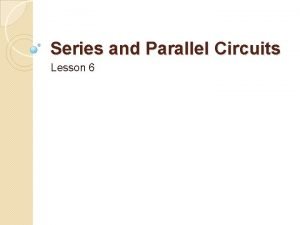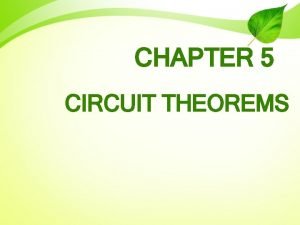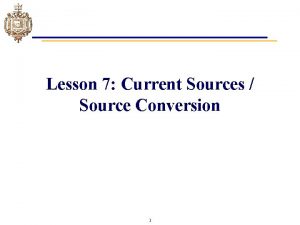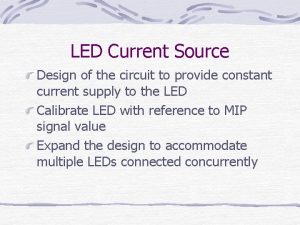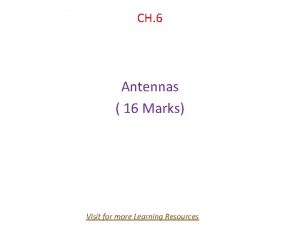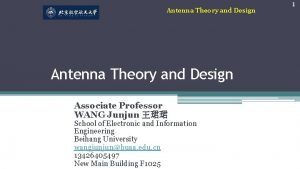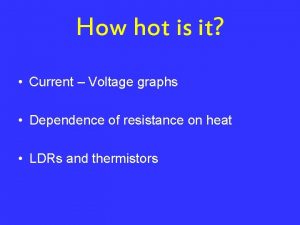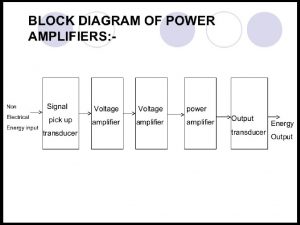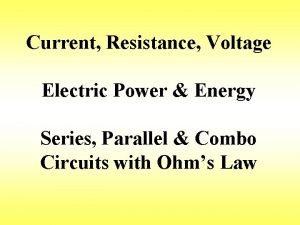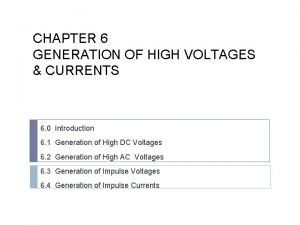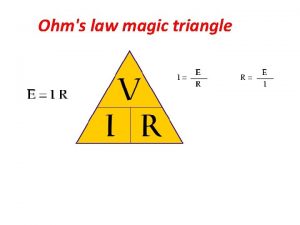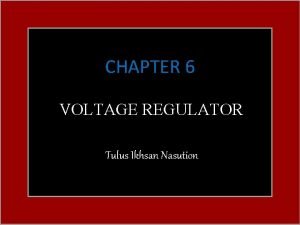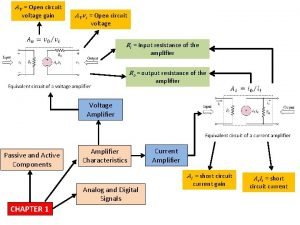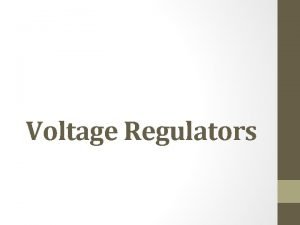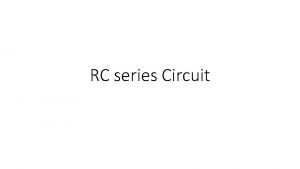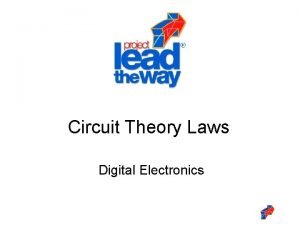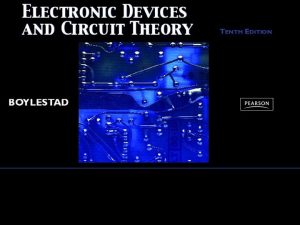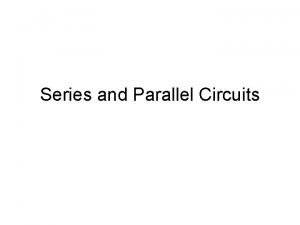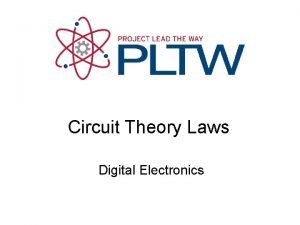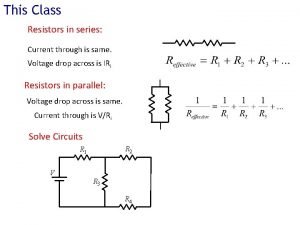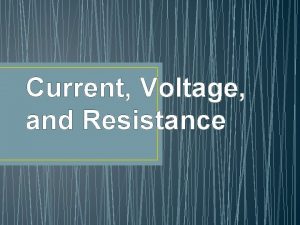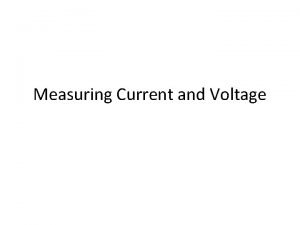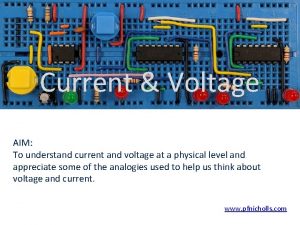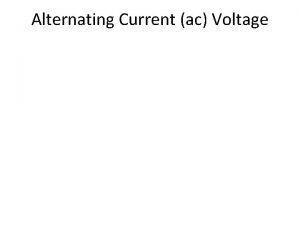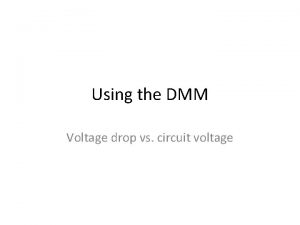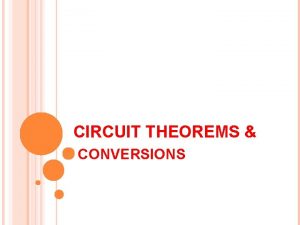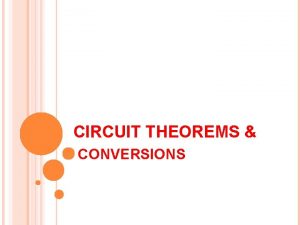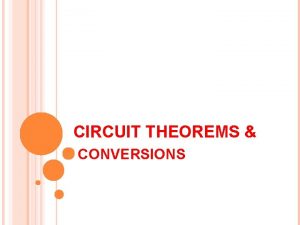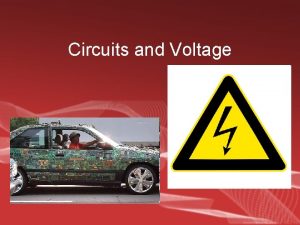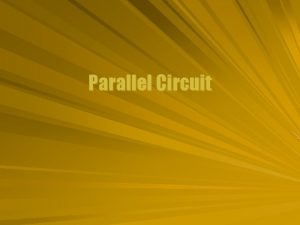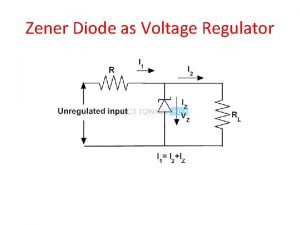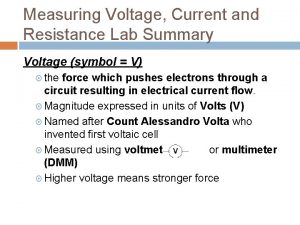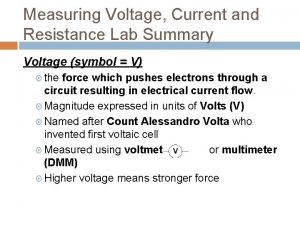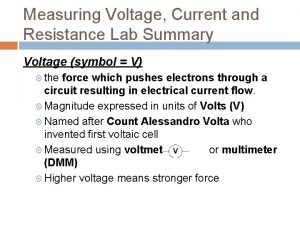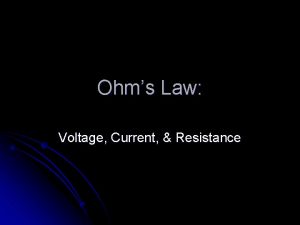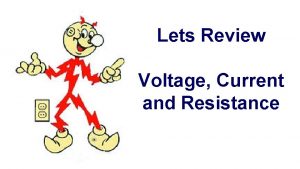ELECTRONIC CIRCUIT Practical Voltage Source Practical Current Source















































- Slides: 47

ELECTRONIC CIRCUIT

Practical Voltage Source

Practical Current Source

Circuit Topology Fundamental

Definition of a branch

Definitions of node and supernode

(a) A circuit containing three nodes and five branches. (b) Node 1 is redrawn to look like two nodes; it is still one node.

Definition of a loop Definition of a mesh

Series Circuits and Kirchhoff’s Voltage Law

Voltage Relationships: Kirchhoff’s Voltage Law • Kirchhoff’s Voltage Law – The sum of the component voltages in a series circuit must equal the source voltage 1840 – German Physicist, Gustav Kirchhoff – Actual wording – The algebraic sum of the voltages around a closed loop is zero – The following equation takes polarity into account

Kirchhoff’s Voltage Law, • Example: VS = +10 V, V 1 = +2 V, V 2 = +8 V

Series Circuit Characteristics • Series Circuit – a circuit that contains only one current path

(a) Series combination of N resistors. (b) Electrically equivalent circuit.

Series Circuit Characteristics • Total Series Resistance where RT = the total circuit resistance Rn = the highest-numbered resistor in the circuit

Series Circuit Characteristics • Current Characteristics – the current at any point in a series circuit must equal the current at every other point in the circuit Insert Figure 4. 5

Series Circuit Characteristics • Voltage Characteristics where VS = the source (or total) voltage Vn = the voltage across the highest numbered resistor in the circuit

(a) Series connected voltage sources can be replaced by a single source. (b) Parallel current sources can be replaced by a single source.

Examples of circuits with multiple sources, some of which are “illegal” as they violate Kirchhoff’s laws.

Series Circuit Characteristics • Power Characteristics where PS = the source (or total) voltage Pn = the power that is dissipated across the highest numbered resistor in the circuit

Series Circuit Characteristics Insert Figure 4. 10

Voltage References • Voltage References - Circuits have a point that serves as the 0 V reference (ground) Insert Figure 4. 12

Voltage Divider • The Voltage Divider Relationship – Voltage Divider – often used to analyze a series circuit where Rn = the resistor of interest Vn = the voltage drop across Rn (where n is the component number)

We may find v 2 by applying KVL and Ohm’s law: so An illustration of voltage division. Thus, or For a string of N series resistors, we may write:

• Source Resistance: A Practical Consideration – Ideal Voltage Source – maintains a constant output voltage regardless of the resistance of its load – Real Voltage Source – internal resistance causes a decrease in load resistance results in a decrease in the source voltage

• Source Resistance: A Practical Consideration (Continued) Insert Figure 4. 20

Maximum Power Transfer Theorem • maximum power transfer from a voltage source to its load occurs when the load resistance is equal to the source resistance

Series-Connected Voltage Sources • Series-Aiding Voltage Sources – the total voltage equals the sum of the voltages • Series-Opposing Voltage Sources – the total voltage equals the difference of the voltages

Earth Ground Versus Chassis Ground Insert Figure 4. 28

Parallel Circuits and Kirchholf’s Current Law

Current Relationships: Kirchhoff’s Current • Kirchhoff’s Current Law: Law – The algebraic sum of the currents entering and leaving a point must equal zero – In other words, the total current leaving a point must equal the total current entering that point i 2 i 1 i 3


Parallel Circuit Characteristics • Parallel Circuit – a circuit that provides more than one current path between any two points Insert Figure 5. 1

Parallel Circuit Characteristics • Current Characteristics where In = the current through the highest-numbered branch in the circuit

Parallel Circuit Characteristics • Voltage and Current Values – Voltage across each component is equal – Current through each branch is determined by the source voltage and the resistance of the branch.

Parallel Circuit Characteristics • Resistance Characteristics – the total circuit resistance is always lower than any of the branch resistance values Insert Figure 5. 5

Parallel Circuit Characteristics • Power Characteristics – Total Power – sum of the power dissipation values for the individual components – The lower value of the branch resistance, the higher percentage of the total power it dissipates (opposite that of series circuits)

Parallel Circuit Characteristics Insert Figure 5. 6

Example: Beginning with a simple KCL equation, or Thus, A special case worth remembering is (a) A circuit with N resistors in parallel. (b) Equivalent circuit.

Parallel Resistance Relationships • Calculating Total Resistance: The Product. Over-Sum Method

Current Sources • a source that is designed to provide an output current value that remains relatively constant over a wide range of load resistance values Insert Figure 5. 12

Current Dividers • Current Dividers – the source current is divided among the branches

The current flowing through R 2 is or An illustration of current division. For a parallel combination of N resistors, the current through Rk is

Practical Current Sources: • The Effects of Source Resistance – Ideal Current Source – constant current and infinite internal resistance – Real Current Source – current varies for a change in load resistance and internal resistance is not infinite – Internal resistance is usually much greater than the load resistance

Series-Parallel Circuits

Series-Parallel Circuits • Connecting Series Circuits in Parallel Insert Figure 6. 3

Series-Parallel Circuits • Connecting Parallel Circuits in Series Insert Figure 6. 5

Analyzing Series-Parallel Circuits
 Lesson 6 current voltage and resistance in a circuit
Lesson 6 current voltage and resistance in a circuit Use source transformation to find vo
Use source transformation to find vo Practical current source
Practical current source Mesh current method with current source
Mesh current method with current source Led current source circuit
Led current source circuit Introduction to high voltage technology
Introduction to high voltage technology Ac voltage control using scr
Ac voltage control using scr Phase to phase voltage
Phase to phase voltage Peak to rms formula
Peak to rms formula The objective of grounding or earthing is
The objective of grounding or earthing is Mig welding voltage chart
Mig welding voltage chart Energy voltage and current
Energy voltage and current Voltage and current series parallel
Voltage and current series parallel Non resonant antenna
Non resonant antenna Current and voltage distribution in antenna
Current and voltage distribution in antenna Ohmic conductor graph
Ohmic conductor graph Difference between voltage and current
Difference between voltage and current Current total in parallel circuit
Current total in parallel circuit Generation of high ac voltage
Generation of high ac voltage Electrical triangle formula
Electrical triangle formula Landline telemetry system
Landline telemetry system Is the electronic exchange of money or scrip
Is the electronic exchange of money or scrip Electronic field production examples
Electronic field production examples Circuit in parallel vs series
Circuit in parallel vs series What is short circuit
What is short circuit Shunt voltage regulator
Shunt voltage regulator Av open
Av open Foldback current limiter
Foldback current limiter Impedence triangle
Impedence triangle Series circuit theory
Series circuit theory Feedback and oscillator circuits
Feedback and oscillator circuits Voltage in parallel circuit
Voltage in parallel circuit What are conductors and insulators
What are conductors and insulators Parallel circuit characteristics
Parallel circuit characteristics Is voltage same in series circuit
Is voltage same in series circuit Parallel circuit voltage
Parallel circuit voltage Electronic current
Electronic current Line current and phase current
Line current and phase current N=nc exp(-eg/2kt)
N=nc exp(-eg/2kt) Ac theory 3 lesson 4
Ac theory 3 lesson 4 Drift current and diffusion current
Drift current and diffusion current What is diffusion current and drift current
What is diffusion current and drift current A jfet always operates with
A jfet always operates with Balanced delta-delta connection
Balanced delta-delta connection Infineon
Infineon Drift current and diffusion current in semiconductor
Drift current and diffusion current in semiconductor In alternators the welding current is produced on the ____.
In alternators the welding current is produced on the ____. Touch current vs leakage current
Touch current vs leakage current
